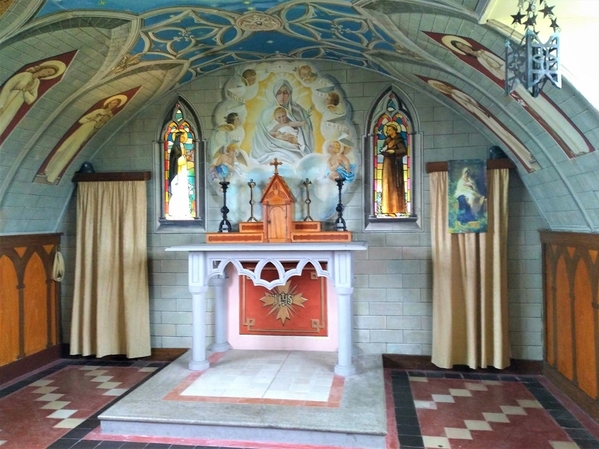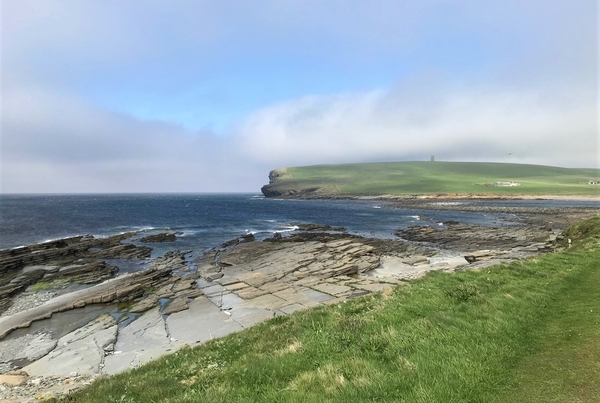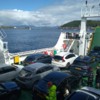The Orkneys are an archipelago about 16 kilometres off the north coast of Scotland consisting of approximately 70 islands, 20 of which are inhabited today. However, overall the Orkney Islands have been inhabited for more than 8,800 years, with Scandinavian clans dominating the area in the 8th century BCE. Norse raiders arrived in the late 8th century and colonised the islands in the 9th century. Subsequently the islands were ruled by Norway and Denmark until they passed into Scottish rule in 1472, along with Shetland.
We spent a couple of days in Orkney on our recent road trip around Scotland. We and our rented car took the 70-minute ferry ride across the Pentland Firth, from Gills Bay on the Scottish mainland to St Margaret’s Hope on South Ronaldsay. From there we drove through another island, Burray, to Orkney Mainland, the principal island.
Orkney Mainland is the largest and the most populous island in Orkney, accounting for 75 per cent of the archipelago’s population. It is the centre of Orkney’s ferry and air connections and serves as a link between the islands to the north and the south.
There are three settlements on the island – Finstown, Stromness and Kirkwall, which is the capital of the islands. Another ferry service operates from Stromness to Scrabster on the Scottish mainland. We stayed at the remote but extremely comfortable Button-Ben Guest House at Stenness, close to Stromness. From there we fanned out to cover almost the entire island.
St Magnus Cathedral in Kirkwall was founded in 1137 by the Viking, Earl Rognvald, in honour of his uncle, St Magnus, who was martyred in Orkney. The Reformation brought ruin to many cathedrals, but St Magnus emerged relatively unscathed although the organ, treasures and rich vestments were removed and the wall decorations were covered in whitewash.
Major restoration work was carried out in the 19th and 20th centuries. Between 1913 and 1930, the main alteration to the exterior of the cathedral was the erection of a tall steeple which replaced the low pyramidal roof of the bell tower. Internally, the screen separating the choir from the nave was removed, along with the pews and galleries. Stained glass windows replaced the formerly plain windows, much of the floor was tiled and the warm red sandstone was revealed by the removal of plaster and whitewash.
The Standing Stones of Stenness could be the oldest stone circle in the UK. There were originally 12 stones, with some standing up to six metres high, focused on a large hearth in the centre. Although only four stones remain standing, it’s still possible to get a sense of the scale and importance of the area.
The stone circle, together with the nearby Ring of Brodgar, forms part of the Heart of Neolithic Orkney UNESCO World Heritage Site. The Ring of Brodgar is the finest known, truly circular late Neolithic or early Bronze Age stone ring. Almost 104 metres wide, it may have originally contained up to 60 megaliths, but only 27 stones remain.
Optical illusion: this oil rig looks like it’s stranded on land, but the waters of Scapa Flow are just over the rise. Orkney is trialling a project aimed at converting North Sea platforms into hydrogen producers.
One of the island’s most cherished attractions is the Italian Chapel built by POWs during World War II from two Nissen huts. The Italians were captured in North Africa and transported to Orkney to construct barriers that would prevent German U-boats from entering the British naval anchorage, following the sinking of the battleship HMS Royal Oak in 1939.
Among the Italians in Camp 60 was an artist, Domenico Chiocchetti, who was given the task of transforming the two Nissen huts into a chapel. He was assisted by other tradesmen – in particular Giuseppe Palumbi, a blacksmith, and Domenico Buttapasta, a cement worker – about 10 men in total. At first only one end of the hut was lined with plasterboard to form a sanctuary and an altar, altar rail and holy water stoop, expertly fashioned from concrete.


The camp commander came to realise that Chiocchetti was a very talented artist and it was decided that the entire chapel should be lined. Chiocchetti then painted it to depict brick walls, carved stone, vaulted ceilings and buttresses. Frescos of angelic figures, stained glass windows and an altarpiece depicting the Madonna and Child surrounded by cherubic figures completed the interior paintwork.
All the materials were scavenged from wherever possible, including timber from a wrecked ship and scrap metal for the tabernacle. Eventually the exterior was also painted and decorated. The chapel is widely recognised as an astonishing work of art and construction, given what the artists and builders had to work with. It receives more than 100,000 visitors a year.
The Brough of Birsay is one of Orkney's most popular sites. For only a few hours each day, when the tide is out, a concrete causeway is revealed, letting people cross to the Brough itself to see its historical remains, dramatic cliffs and, if you’re lucky (we weren’t), puffins.

There is a splendid walk north from the beach, taking in the rugged coastline, old fishermen's huts and the Birsay whalebone, which has been in place for more than a century. Here and at Marwick Head (above) are good spots for bird watching.
These pictures capture the rugged beauty of Orkney but unfortunately also the weather, which is often overcast and misty. Old shipwrecks can be seen in the shallows and sheep graze alongside local dwellings. The islands have an abundance of wildlife, with seabirds dominating the cliffsides and shores.
Photos © Judy Barford






Comments (1)